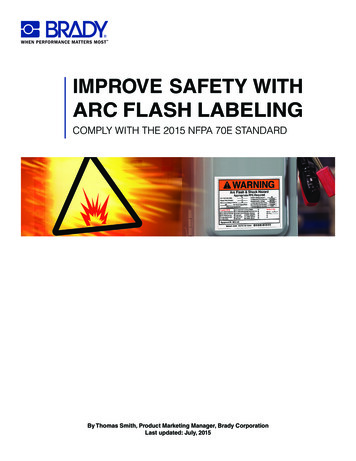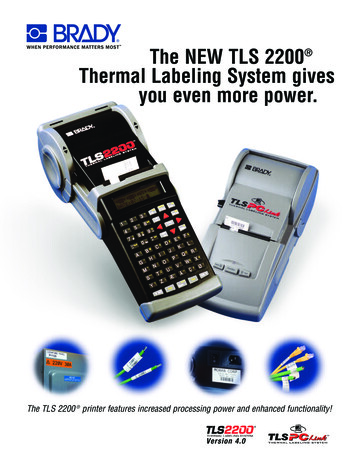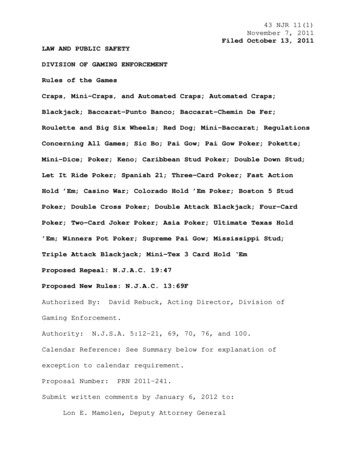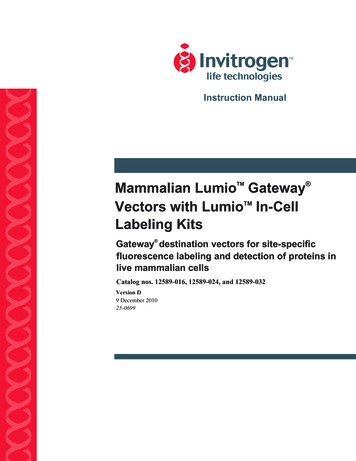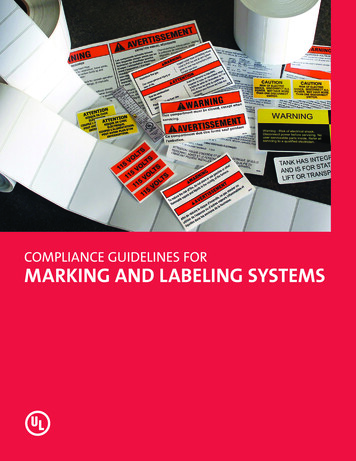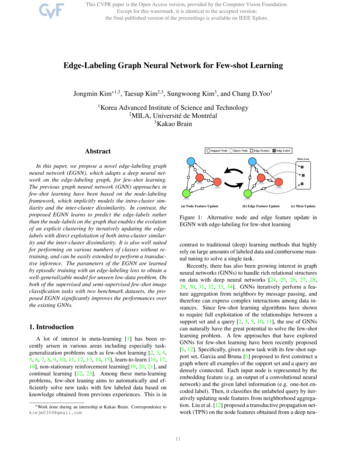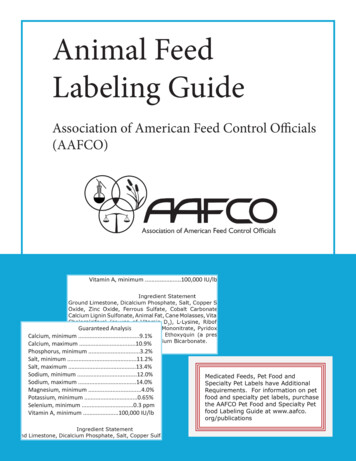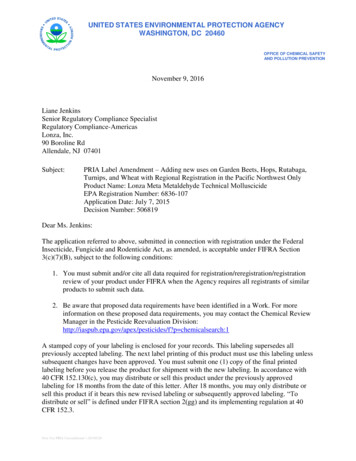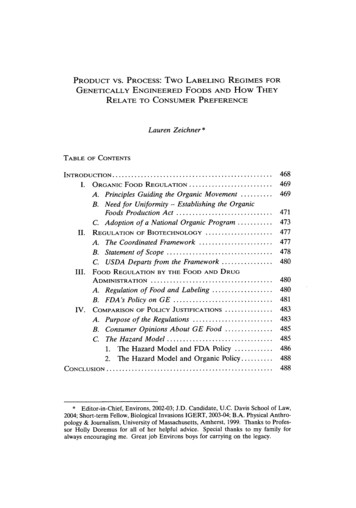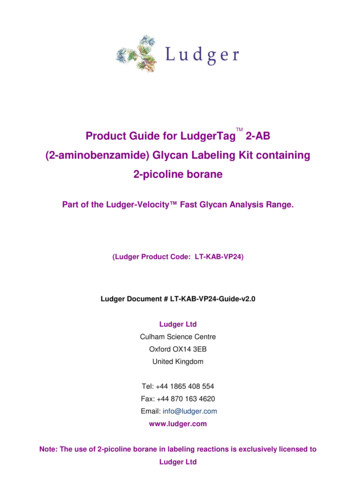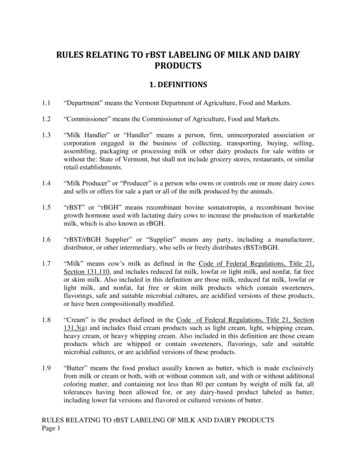
Transcription
RULES RELATING TO rBST LABELING OF MILK AND DAIRYPRODUCTS1. DEFINITIONS1.1“Department” means the Vermont Department of Agriculture, Food and Markets.1.2“Commissioner” means the Commissioner of Agriculture, Food and Markets.1.3“Milk Handler” or “Handler” means a person, firm, unincorporated association orcorporation engaged in the business of collecting, transporting, buying, selling,assembling, packaging or processing milk or other dairy products for sale within orwithout the: State of Vermont, but shall not include grocery stores, restaurants, or similarretail establishments.1.4“Milk Producer” or “Producer” is a person who owns or controls one or more dairy cowsand sells or offers for sale a part or all of the milk produced by the animals.1.5“rBST” or “rBGH” means recombinant bovine somatotropin, a recombinant bovinegrowth hormone used with lactating dairy cows to increase the production of marketablemilk, which is also known as rBGH.1.6“rBST/rBGH Supplier” or “Supplier” means any party, including a manufacturer,distributor, or other intermediary, who sells or freely distributes rBST/rBGH.1.7“Milk” means cow‟s milk as defined in the Code of Federal Regulations, Title 21,Section 131.110, and includes reduced fat milk, lowfat or light milk, and nonfat, fat freeor skim milk. Also included in this definition are those milk, reduced fat milk, lowfat orlight milk, and nonfat, fat free or skim milk products which contain sweeteners,flavorings, safe and suitable microbial cultures, are acidified versions of these products,or have been compositionally modified.1.8“Cream” is the product defined in the Code of Federal Regulations, Title 21, Section131.3(a) and includes fluid cream products such as light cream, light, whipping cream,heavy cream, or heavy whipping cream. Also included in this definition are those creamproducts which are whipped or contain sweeteners, flavorings, safe and suitablemicrobial cultures, or are acidified versions of these products.1.9“Butter” means the food product usually known as butter, which is made exclusivelyfrom milk or cream or both, with or without common salt, and with or without additionalcoloring matter, and containing not less than 80 per centum by weight of milk fat, alltolerances having been allowed for, or any dairy-based product labeled as butter,including lower fat versions and flavored or cultured versions of butter.RULES RELATING TO rBST LABELING OF MILK AND DAIRY PRODUCTSPage 1
1.10“Cheese” means specific cheeses „for which a standard of identity is listed in the Code‟of Federal Regulations, Title 21, Part 133, and/or any non standardized dairy basedproduct labeled as “cheese”1.11“Sour Cream” is the product defined in the Code of Federal Regulations, Title 21 Section 131.160, and includes reduced fat sour cream, lowfat or light sour cream, andnonfat or fat free sour cream. Also included in this definition are those sour cream,reduced f at sour cream, lowfat or light sour cream, and nonfat or fat free sour creamproducts which contain sweeteners, flavorings, safe and suitable microbial cultures, orare acidified versions of these products.,1.12“Ice Cream” Is the product defined in the Code of Federal Regulations, Title 21, Section135.110, and includes reduced fat ice cream, lowfat or light ice cream, and nonfat or fatfree ice cream.1.13“Frozen Desserts” means any dairy derived frozen dessert not conforming to definition1.12.1.14“Buttermilk” is a fluid product resulting from the manufacture of butter from milk orcream. It contains not less than 8.25 percent of milk solids not fat.1.15“Half-and-half” is the product defined in the Code of Federal Regulations, Title 21,Section l3l.180 and includes Half-and-half with safe and suitable microbial cultures or isacidified. „1.16“Yogurt” is, the product defined in- the Code of Federal Regulations Title 21, Section131.200, and includes reduced fat yogurt, lowfat or light yogurt, and nonfat or fat freeyogurt. „1.17 “Infant Formula” means any dry, concentrated, condensed, orliquid food product ,which is intended to be „fed to infants, which after the removal ofvitamins, minerals, and flavoring ingredients consists of dairy derived ingredients.1.18“Condensed/Dry Milk Products” means milk as defined in Definition 1.7 which hasbeen concentrated, condensed, or dried by the removal of water therefrom and isintended to be reconstituted with water back to its original form or is intended to be usedas an ingredient in a milk product defined in these rules.1.19“Condensed/Dry Whey Products” is a product resulting from the manufacture of cheesefrom milk or cream, which has been concentrated, condensed, or dried by the removal ofwater therefrom and is intended to be reconstituted with water back to its original form oris intended to be used as an ingredient in a milk product defined in these rules.RULES RELATING TO rBST LABELING OF MILK AND DAIRY PRODUCTSPage 2
1.201.21“Egg Nog” is the product defined in the Code of Federal Regulations, Title 21, Section131.170”, and includes reduced fat egg nog, lowfat or light egg nog, and nonfat or fatfree egg nog.“Person” „means individuals, corporations, partnerships, trusts, associations,cooperatives, and any and all other business units or entities. „ -1.22“Label” „means- a display of written, printed,, or graphic‟ material upon the immediatecontainer of any article or any of its containers or wrappers, or accompanying sucharticle.1.23“rBST/rBGH-free claim” means any direct or implied claim that a milk or milk productis made from milk produced without the use of recombinant bovine somatotropin.2. VOLUNTARY LABELING2.1A person may, in connection with the sale of milk or milk products packaged in retailcontainers and offered for sale in Vermont, represent that the milk or milk product isderived from cows not treated with rBST/rBGH if the representation complies with thissection. This subsection does not prohibit the use of other rBST/rBGH-free claims solong as they comply with this section.2.2No person may do any of the following in connection with the sale of milk or a milkproduct:2.32.2aMake any rBST/rBGH-free claim that is false, deceptive or misleading.2.2bMake any rBST/rBGH-free claim without appropriate qualifying statements under2.3.2:2cMake any rBST/rBGH-free claim unless that person. possesses reasonablesubstantiation for that claim when the claim is made. , Substantiation shall complywith Section 3.1 through 4.3 of these rules.2.2dRepresent, directly or by implication, that a dairy product contains no bovinesomatotropin. Since bovine somatotropin occurs naturally in milk, a statementthat milk is “BST-free” or BGH-free” is false unless the statement „is clearlymodified to refer to rBST or rBGH.2.2eMake any rBST/rBGH-free claim for a milk or milk product if that milk or milkproduct is made with milk from cows treated with rBST/rBGH.No person may make a rBST/rBGH-free claim in connection with the sale of milk ormilk products unless that claim includes one of the following qualifying statements:RULES RELATING TO rBST LABELING OF MILK AND DAIRY PRODUCTSPage 3
2.3aA clear and conspicuous statement that the U.S. Food and Drug Administrationhas not found a significant difference to exist between milk derived from rBST treated and non-rBST-treated cows, or such other truthful and non-misleadingstatement conveying reasons, other than safety and quality, for choosing to usemilk or dairy products which have not had rBST used in their production.2.4Qualifying statements must normally be at least as clear and conspicuous as the“rBST/rBGH-free” claim, and must be made directly in conjunction with the“rBST/rBGH-free” claim.2.5The type size of the qualifying statements shall not be less than 1/2 the type size of theprincipal rBST/rBGH-free claim. Upper case and lower case letters must be not less than1/16inch in height.3. SUBSTANTIATING rBST/rBGH CLAIMS3.1The following requirements are hereby imposed on any milk producer selling to a personwishing to label milk or milk products as being derived from cows not treated withrBST/rBGH and selling those products for retail sale in Vermont.3.2No person may make an “rBST/rBGH-free” claim in connection with the advertising,sale or distribution of milk or a milk product in this state unless that person possessesreasonable substantiation for that claim at the time the claim is made. If the personmaking the claim received raw milk from producers, substantiation must include swornaffidavits from those producers stating that:3.2aNo animals on the affiant‟s farm are currently being treated with rBST/rBGH. .3.2bNo animals on the affiant‟s farm have received rBST/rBGH treatments within thepast 90 days.3.2c Affiant will not knowingly allow animals to be brought into his or her dairy herdwith have been treated with rBST/rBGH in the past 90 days.3.2dAffiant agrees to provide at least 90 days written notice to the buyer of his or hermilk of affiant‟s intention to use rBST/rBGH on his or her dairy herd.3.2eAll affidavits shall recite that they are made under penalty of perjury and shall „besigned and sworn to before a notary public.RULES RELATING TO rBST LABELING OF MILK AND DAIRY PRODUCTSPage 4
3.3 If the person making a “rBST/rBGH-free” claim for milk or a milk product does not receiveraw milk from producers that person must obtain an affidavit from all milk handlers sellingmilk and milk products affirming to the receiving handler that milk sold to the receivinghandler is from producers in compliance with rule 3.2.4. PRODUCER AFFIDAVIT4.1Under this rule, a milk producer affidavit used to substantiate an “rBST/rBGH-freeclaim” must be a sworn and notarized statement, signed by the milk producer, whichcontains the affirmations set forth in Section 3.2 of these rules.4.laAny producer affidavit executed after June 30, 1994, shall be deemed valid if itcomplies with the-requirements of Vermont law and these rules, and if theproducer has not informed a handler in response to a letter sent by a handler inaccordance with section 4.3 of these rules ,that the producer will not comply withthe 90 day notice -requirements of 6 V.S.A. §2762.4.2No milk producer signing an affidavit may, contrary to that affidavit, use rBST/rBGH inthe production of milk. No milk producer in this state may withdraw or cancel anaffidavit unless that milk producer gives the recipient of that affidavit at least 90 daysprior written notice of that withdrawal or cancellation. No milk producer may, while hisor her affidavit remains in effect, knowingly add to his or her herd a cow that has beentreated with rBST/rBGH within the previous 90 days.4.3Each handler may send to a producer from whom the handler has been notified byaffidavit that the producer will comply with any 30 day requirement regarding the use ofrBST, a letter to the effect that, unless informed otherwise by the producer, the produceris agreeing that it will instead comply/with any 90 day requirement contained in 6 V.S.A.§2762.4.4No milk handler may rely upon a milk producer affidavit to substantiate an “rBST/rBGHfree claim” if:4.4aHe/she knows, or has reason to know, that the milk producer has withdrawn orcancelled that affidavit, or if4.4bHe/she knows, or has reason to know, that the producer who signed the affidavitis using rBST/rBGH in milk production.RULES RELATING TO rBST LABELING OF MILK AND DAIRY PRODUCTSPage 5
5. HANDLER AFFIDAVIT5.1The milk handler shall by affidavit, notify the Commissioner of the handler‟s practicesadopted to assure that milk from cows not treated with rBST/rhGH is kept separate fromother milk throughout the collection, transportation and processing steps until the finishedmilk or dairy product is in final packaged form in a labeled container, and swears that heor she will notify the Commissioner at least 90 days before ceasing use of such practices.5.2,The milk handler Shall at least annually notify the Commissioner of all products andbrand labels for which a rBST/rhGH claim is being made.5.3The milk handler shall notify the Commissioner at least 90 days before a change inrBST/rBGH claim of any product or brand label processed or distributed by the milkhandler.5.4A handler whose affidavit claims:A)That all milk or dairy products marketed under a given brand, name are „derivedfrom cows not treated with rBST/rBGH, may state in an advertisement, eitherverbally or written, or in a point of sale display that the entire line of milk or dairyproducts with this brand name is derived from cows not treated with rBST/rBGH.B).That some milk or dairy products marketed under a given brand name are derivedfrom cows not treated with rBST/rBGH, but makes no such claim regarding othermilk or dairy products with this brand name, shall in, any advertisement, eitherverbally or written, of rBST/rBGH free milk or dairy product, or in a point of saledisplay, identify the specific milk or dairy product or products with this brandname derived from cows not treated with rBST/rBGH.6. COMMISSIONER’S VERIFICATION6.1The Commissioner is authorized to conduct random inspections of dairy farm operationsto determine whether evidence exists that rBST/rBGH is or has been used in theproduction of milk, which may include inspection of a milking herd, historical milkproduction records, and medicine storage places. If an inspection finds evidencecontradicting the claim of a producer made under Section 3.2 of these rules, theCommissioner shall immediately so notify the attorney general and the handlerconcerned.6.2The Commissioner is authorized to investigate when he or she deems appropriate, and theCommissioner shall at least annually review, the business operations of any milk handlerwho claims pursuant to this subchapter that rBST/rBGH has not been used in theRULES RELATING TO rBST LABELING OF MILK AND DAIRY PRODUCTSPage 6
production of milk or dairy products offered for retail sale in Vermont, for the purpose ofverifying such claims. An investigation or an annual review may be made, if theCommissioner deems appropriate, of claims of non-rBST/rBGH use in the production inother states or countries of milk or dairy products offered for retail sale in Vermont,pursuant to 6 V.S.A. §2767. An investigation or a review may include the examination ofa milk handler‟s collection, transportation, processing or manufacturing equipment,methods and historical records, including records of milk pickups and deliveries.6.36.4The Commissioner is authorized to confirm a producer‟s claim of non-rBST/rBGH usepursuant to section 3.2 of these rules:(1)in conjunction with the random inspection of dairy farm operations pursuant toSection 6.1 of these rules;(2)upon the written request of a handler regarding specific producers supplying milkto the handler; or(3)when the Commissioner has reason to suspect that a specific producer has made afalse affidavit.Any supplier of rBST/rBGH doing business or wishing to „do business in Vermont shallregister with „the, Commissioner. In the event the Commissioner is investigating aproducer‟s claim of non-rBST/rBGH use pursuant to Section 6.2 of these rules, a suppliershall, when requested by the Commissioner, make available to the Commissioner recordsof business transactions with the producer under investigation by the Commissioner.6.4a“Registration” under this section means to provide the supplier‟s name, address,telephone number, and name and address of any corporate agent, to theCommissioner, or to the Vermont Secretary of State under Chapter 15 of Title 11.6.5The Commissioner shall annually prepare a list of each milk handler, and of each milk ordairy product of the handler concerned, whose claim of non-rBST/rBGH use pursuant toSection 2 of these rules has been validated. The list shall be available to the public uponrequest.6.6If the Commissioner determines that the claims of a milk handler of non-rBST/rBGH usepursuant to Section 2 of these rules cannot be verified, the Commissioner shallimmediately so notify the Attorney General and the handler concerned.RULES RELATING TO rBST LABELING OF MILK AND DAIRY PRODUCTSPage 7
7. ENFORCEMENT PENALTY7.1A violation of these rules may give rise to a civil, administrative or criminalenforcement action under Title 9, Title 6 or Title 13.7.2The commissioner may seek search warrants and accept assurances of discontinuanceunder sections 1, 12, and 13 of Chapter 1, Title 6, or may suspend or revoke thelicense issued to a milk handler under 6 V.S.A. §2721 and §2855 who violates theserules.7.3The Attorney General or State‟s Attorney may prosecute civil, criminal oradministrative actions in accordance with the Civil and Criminal Rules of Procedureand the Administrative Procedure Act.8. MILK PURCHASE REFUSAL8.1if the Attorney General commences an enforcement action against a milk producer fora false affirmation, claim or affidavit pursuant to applicable Statutes and these rules,the charge shall be a matter of public record and a handler purchasing milk from theproducer may immediately refuse to purchase and accept milk from that producer,notwithstanding the provisions of 6 V.S.A. §2752.9. RECIPROCITY9.1A person may offer for retail sale in this state milk and dairy products from otherstates and countries, the label of which displays the claim that rBST/rBGH has notbeen used in the production of the milk or dairy products, if the milk or dairy productsare identified by the Commissioner:(1)as from a state or country which has a law comparable to this subchapter andthe milk or dairy products are labeled in compliance with the laws of that stateor country, or employs other methods administered by the state or countryacceptable to the Commissioner for verifying claims that rBST/rBGH has notbeen used in milk production and processing;(2)as provided by a handler which employs a method acceptable to theCommissioner for verifying claims that rBST/rBGH has not been used in milkproduction and processing, or(3)as from a state or country with a law or laws precluding the use of rBST/rBGHin the production of milk.RULES RELATING TO rBST LABELING OF MILK AND DAIRY PRODUCTSPage 8
10.10.1SEVERABILITYThe provisions of these rules are severable. If any provision is invalid, or if anyapplication thereof to any person or circumstance is invalid, the invalidity shall not affectother provisions or applications which can be given effect without the invalid provisionor application.RULES RELATING TO rBST LABELING OF MILK AND DAIRY PRODUCTSPage 9
somatotropin. Since bovine somatotropin occurs naturally in milk, a statement that milk is "BST-free" or BGH-free" is false unless the statement „is clearly modified to refer to rBST or rBGH. 2.2e Make any rBST/rBGH-free claim for a milk or milk product if that milk or milk product is made with milk from cows treated with rBST/rBGH.
